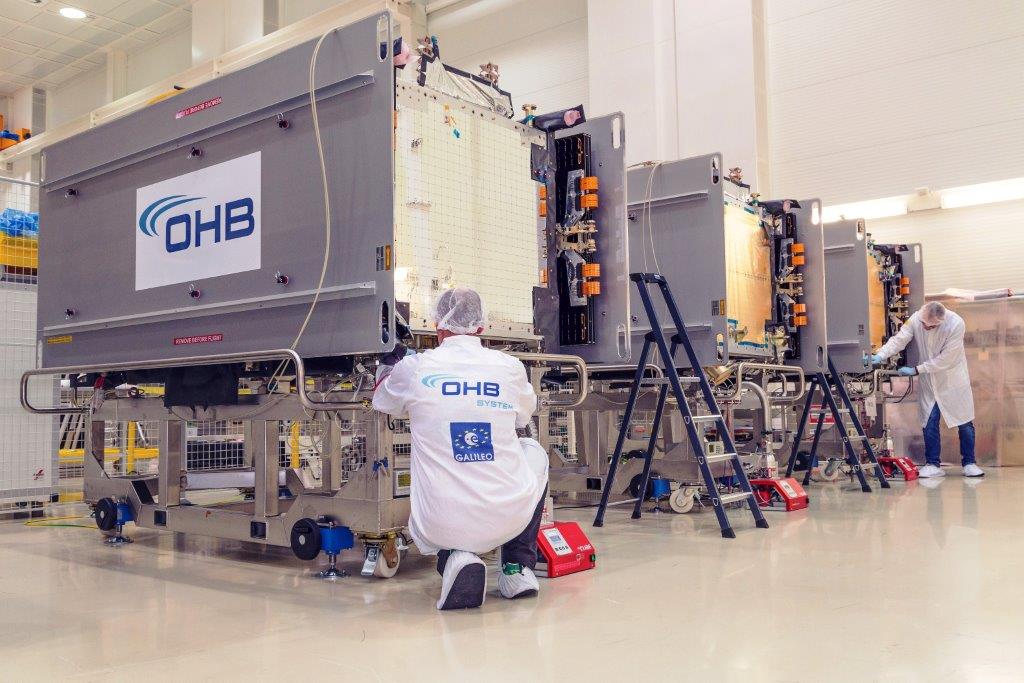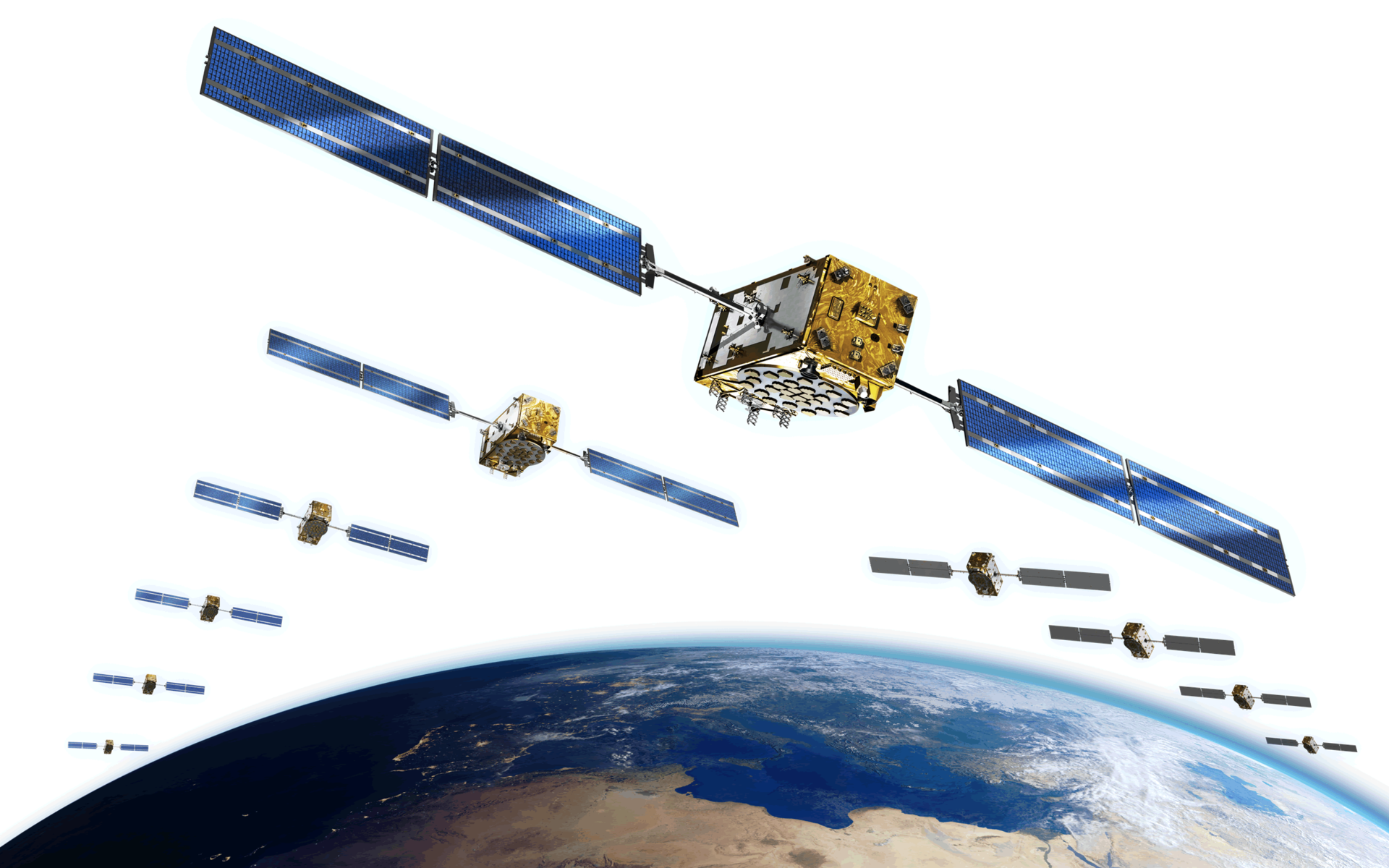Bremen, January 31, 2019 Four navigation satellites today were declared ready to join the constellation of the European satellite navigation system Galileo. The reason is the successfully completed test phase of the satellites in space. The Galileo FOC* satellites had been supplied by the space technology company OHB System AG and launched from the European launch site in Kourou, French Guyana, in July 2018. They will reinforce the satellite constellation, further boosting the capabilities of the European satellite navigation system.
The Galileo satellites** operate in space at an altitude of approx. 23,000 kilometres. They enable citizens in Europe and all over the world to make use of a large variety of helpful navigation applications. Moreover, thanks to Galileo, Europe managed to gain its independence from other global satellite navigation systems like GPS or Glonass. From the year 2020, replacement satellites will be made available to the Galileo constellation – likewise “made by OHB”.
“OHB has done a tremendous job in delivering quality satellites in record time. We wish to thank all their teams for their dedication and are looking forward to continue our partnership,” says Paul Verhoef, ESA Director of Navigation.
“As you can probably imagine, today fills me with immense pride. It certainly is something very special when you consider that millions of people can now receive more accurate navigation data, especially thanks to the OHB satellites, enabling rescue services to reach their places of deployment faster and allowing businesses and the economy to rely on the time stamps delivered by the satellite system. The usefulness of space technology is directly felt by most citizens in their everyday lives through navigation services,” says Wolfgang Paetsch, the Management Board member responsible for navigation, earth observation and science at OHB System AG. “OHB System AG has so far managed to assert itself in three public tender rounds as a producer of satellite platforms and as a system leader, being commissioned to develop, build and test a total of 34 Galileo satellites by the European Space Agency (ESA). 22 of these satellites are in orbit and have managed to deliver proof of their full functionality in space”.
Serial production launched
In the third public tender round, ESA once again opted for the expertise of OHB System AG, ordering a further 12 satellites in 2017 – the “replacement crew members”, as it were. “We took up serial production at our tried-and-tested production islands again in December 2018. We now intend to take up production of a further satellite every six weeks”, explains Dr Kristian Pauly, Director of Navigation at OHB.
The first two replacement satellites for the satellite system Galileo will be ready for launch in autumn 2020. “At that point in time, the other ten satellites will be at different stages of production. We will complete two additional satellites every three months”, says Dr Pauly.
Step by step towards full system completion
Europe's own global navigation system Galileo makes various services available for positioning, navigation and timing. In its final configuration, it will comprise 24 satellites arranged at three levels plus reserve satellites and a worldwide network of tracking (earth) stations.
The first services were made available in December 2016. Each satellite newly integrated into the satellite constellation enhances the stability and speed of the system. Presently, more than 70 types of smartphones able to receive Galileo signals are available in Europe, and more than 500 million Galileo devices were sold until October 2018. The latest smartphones available do not only receive GPS and Glonass, but also the open navigation service on offer to the public at large. The Public Regulated Service from Galileo is geared to institutional users such as public authorities, police or the fire brigade. The search-and-rescue service facilitates accurate and reliable localisation of distress signals – speedier arrival of rescue teams on the scene of an accident can mean the difference between life and death.
The next generation of satellites is taking shape – in the experts’ heads
At OHB, a great deal of thinking has already gone into what a future-proof next generation of satellites must be able to perform. Various satellite designs and mission concepts were conceived and tested. OHB would once again like to submit a compelling offer to the European Space Agency. “In future, the users should stand to benefit from further improved signals and services. I assume that we cannot even foresee at this stage what future applications will have been developed by that time. We are also looking for ideas as to how operation could be cost-optimised – not least because the citizens of Europe are the owners of the system. We are also focusing on security aspects,” explains Wolfgang Paetsch. “We can actually build on an immense wealth of experience derived from projects commissioned to date. In combination with our ideas, the concepts developed and our intention to continue making a decisive contribution to Galileo, we can certainly submit an attractive offer again.”
* The phase until reaching full operational capability – (FOC) of the Galileo Programme is being funded by the European Union. The European Commission and the European Space Agency ESA have signed a transfer agreement providing for the ESA to act on behalf of the Commission as the entity responsible for development and procurement. The views expressed here do not necessarily constitute the positions of the European Union or ESA. Galileo is a registered trade mark owned by the EU.
** The present constellation comprises IOV (In-Orbit-Validation) satellites and FOC (Full Operational Capability) satellites.

Contact for media representatives:
Marianne Radel
Head of Corporate Communications
Phone: +49 421 2020 9159
Email: marianne.radel@ohb.de
Contact for investors and analysts:
Marcel Dietz
Investor Relations
Phone: +49 421 2020 6426
Email: ir@ohb.de

